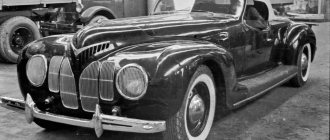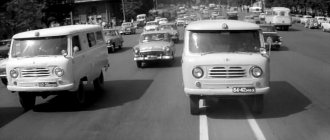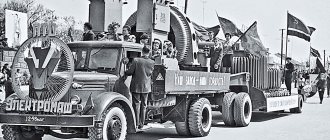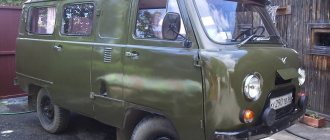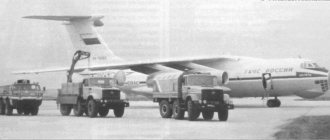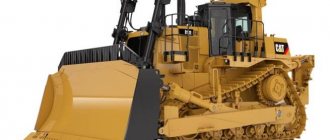ZIL-4102
In the mid-80s, the winds of change blew in the Soviet Union. The new General Secretary, Mikhail Gorbachev, led the country on a new course of restructuring, acceleration and democratization. Among other things, the history of the new generation Soviet executive car, which was developed in the 80s, but never went into production, is also connected with the figure of the first and last president of the USSR. The creation of this machine was carried out by specialists from the Likhachev plant; the first prototype was ready by 1988. The car received the designation ZIL-4102.
Compared to the heavyweight representatives of the ZIL-4104 line, the new limousine was lighter, more compact, and more democratic. Based on the ZIL-4102 car, they planned to create a whole family of executive and special vehicles. But it didn’t come true... The General Secretary did not like the product of Zilov’s designers, so the car never made it into the series. Alas, sometimes the result of many years of painstaking work of an entire team depends on the whim or tyranny of one person endowed with supreme power.
In total, two prototypes of the new car were made; the factory workers gave them names in honor of the reformer secretary general and his first lady. And they did it in the most familiar manner possible: the limousines received the names “Mishka” and “Raika”. The black “Bear” (No. 001) was lost many years ago, all that remained of it was the “face” with a bumper, radiator grille and headlights. The only surviving example of this government sedan is the light brown Raika (No. 002). They say that today it is in one of the private collections. In general, the project to create a limousine for the last Soviet general secretary can be called one of the most little-known pages in the history of the domestic automobile industry.
All that remains of “Mishka” - car ZIL-4102 No. 1
Due to the reduction in weight, acceleration from zero to 100 km/h became slightly faster - 10.5 seconds.
0
Source:
Fuel consumption per 100 kilometers was 18 liters at a speed of 90 km/h and 21 liters at 120 km/h, which is relatively little for such large cars.
0
Source:
In the ZIL-4102 cabin there were no folding seats (strap seats) for security. The guard can only ride in front. In ZIL-4102, all luxury was placed at the disposal of four people, including the driver. The split rear seats were electrically adjustable, there was a control panel for lighting and air conditioning on the ceiling, and there were folding footrests for passengers on the floor.
0
Source:
The front seats were still separated by a wide central tunnel. As a result, all four of them sat, as it were, in the corners of the huge salon. The interior was trimmed with light velor, cream leather and natural wood inserts.
Design and arrangement of the car interior ZIL-4102
ZIL-4102 is a four-door sedan with a front engine and driven rear wheels. Although the car turned out to be 500 kg lighter than the ZIL-41041, its dimensions were still very impressive: the length was half a meter longer than the serial Volga. It can also be added that the appearance of the ZIL-4102 was very different from the executive cars produced at the plant named after. Likhachev earlier.
The main design features of the car are the monocoque body and the absence of a frame, which led to a high level of vibration. The designers could not solve this problem for a long time, but in the end they achieved victory by reducing the oscillations to an acceptable 25-28 Hz. To reduce noise, the engine and gearbox were covered with special covers.
Under the hood of ZIL-4102
All parts of the ZIL-4102 body were made and adjusted by hand; 10-15 layers of paint were applied to each of them, with each layer always dried and polished. Composite materials were widely used in the design of the ZIL-4102, which can be called a novelty for the domestic automobile industry. The bottom and roof panels, bumpers, hood and trunk lid were made from fiberglass. This solution made it possible to reduce the total weight of the vehicle.
The rear and windshield were attached using special glue, and the roof panel was installed in the same way.
The car's interior was designed for four people, including the driver and a security guard, whose seat was in the front. There were no folding seats for security, as on previous ZIL vehicles. The rear seats were separate and could be adjusted electrically. They were separated from the front seats by a massive floor partition with retractable foot rests.
On the rear ceiling of the cabin there was a control panel for air conditioning and lighting. The air conditioning system included two independent climate control units.
The upper part of the interior was trimmed with velor and light-colored leather, the lower part was covered with dark carpet.
Nameplate from ZIL-4102
All multimedia systems that existed at the time of the car's release were available to passengers. In the cabin there were:
- digital tuner;
- cassette player;
- audio system consisting of ten speakers.
In addition, the ZIL-4102 was equipped with an on-board computer with a voice synthesizer, which was specially ordered in Germany.
The limousine had three-layer athermal windows, which were lowered and raised using electric lifts.
The car was equipped with an on-board computer with a speech synthesizer.
0
Source:
As on previous models, to ensure reliability, some of the vehicle’s units and electrical systems were duplicated: two batteries, two fuel pumps, a backup ignition and brake system.
0
Source:
ZIL-4102 was launched as a project in 1982, although the concept was finally formulated only in 1985. Then we prepared a detailed technical specification for two modifications - 4101 (limousine) and 4102 (sedan), the difference in length was 46 centimeters. And this was the first project of a ZIL passenger car that could go on sale. Maybe not very freely, but still. After all, it was planned to completely re-equip production for the 4101/4102 line, purchase new machines and equipment, and make machines not just in units per year, but in hundreds or even thousands.
0
Source:
The new passenger ZIL was supposed to have a large number of modifications and be distributed in accordance with the nomenclature status of the consumer - from simple versions for the regional party elite, to a heavy armored limousine.
0
Source:
In 1988, ZIL's sixth workshop produced two prototypes of the ZIL-4102 car. The sedan was shown to the delegates of the 19th Party Conference. The first and last president of the Soviet Union, Mikhail Sergeevich Gorbachev, did not approve of the promising prototype, which would require huge costs to put into production.
0
Source:
Why did they decide to show Gorbachev a sedan? Apparently, the “wind of perestroika changes” played a role, still weak, but still tangible. ZILists hoped that the presentation of a more modest car would fit into the fabric of Gorbachev’s fight against free nomenklatura luxury. But they didn’t take into account that Mikhail Sergeevich is a living person and does not always think the way he says and does. He was simply not impressed by the sedan, which lacked imperial monumentality. And work on the ZIL-4102 car was slowly curtailed. Only the brown-gray Raika with chassis number 002 has survived to this day, and another black ZIL-4102 (chassis number 001) was disposed of in the mid-90s of the last century - only the “face” with headlights and trim remained from it radiator and bumper. During the existence of the USSR, a unique team of designers of executive cars was formed at ZIL, and its own school was created, however, the difficult situation at the plant in the early 1990s did not allow the development of passenger cars to continue.
How a limousine was created for the last Soviet Secretary General
In the mid-80s, the main limousine for the Soviet party nomenclature was the ZIL-4104 and its modifications - ZIL-41045 and ZIL-41047. It was a truly monumental car - a real symbol of the Soviet empire, as strict and official as possible. At the time of its adoption, the ZIL-4104 was the longest production vehicle in the world. Not only did it carry the top of the country, a large number of special modifications were created on the basis of this limousine, including a security vehicle, a VIP ambulance, and special communications vehicles. However, already in the early 80s, the ZIL-4104 began to gradually become obsolete.
During the creation of the car, designers had to create many mock-ups. This is one of them.
There is an opinion that the direction for the development of ZIL-4102 was given personally by the new General Secretary of the CPSU Central Committee, Mikhail Gorbachev, but this is not entirely true. The designers of the Likhachev plant began implementing this project back in 1982. It was planned to replace the five-seater ZIL-41041 sedan with a new car. At the same time, work was underway on an extended modification of the car with a limousine body, but in this case it did not even get to the point of creating a prototype. The car project was led by E.D. Gusev, the chief designer of the plant.
The development of the concept of the new car was difficult. For study - or copying - a British Rolls-Royce Silver Spirit limousine was purchased, the features of which can be easily seen in the appearance of the ZIL-4102. At the same time, the Soviet limousine is somewhat subtly similar to the Volvo 760 and the American Cadillac Fleetwood Limousine.
During the implementation of the project, a large number of mock-ups were made, on which not only the design of the future car was worked out, but also its aerodynamic shape was improved. The final design concept for the car was formed only in 1985.
As a result, the order for the production of two experimental cars was transferred to the sixth workshop of the enterprise, which was engaged in the manufacture of products for Soviet VIPs.
Suspension and brakes
For the first time, independent suspension on all wheels was introduced for ZIL passenger cars. Springs with the function of damping “dive” during acceleration and braking were used as shock-absorbing elements. When developing suspensions, the experience of the world's leading automotive concerns was used. The suspension units were assembled on separate subframes. The steering mechanism with a “screw and gear sector” type gearbox was equipped with a hydraulic booster.
The rear suspension was equipped with oblique trailing arms and a stabilizer. The front suspension did not have kingpins in its design and was also equipped with a stabilizer.
A heavy and dynamic car needed a powerful braking system. All brake mechanisms on ZIL-4102 are disc. Due to the increased diameter of the brake discs, the car received new 17-inch wheels. The old 16-inch wheels simply did not accommodate the new brake mechanisms. The hydraulic brake drive had three boosters - one vacuum and two hydraulic vacuum.
New solutions in body design
The ZIL-4102 car with a sedan body fully corresponded to the wishes of the Secretary General. But the time frame for building the first sample was very tight - no more than 6 months were allotted for all work. Due to tight deadlines, development of design and construction solutions was carried out on a full-size sedan mock-up.
As a result, the design team led by E.D. Gusev managed to create a car with solutions that were completely uncharacteristic of ZIL products. To facilitate the design, the body of the ZIL-4102 was made according to a load-bearing design. Composite materials were used in the design of a number of body parts, which increased body rigidity and further reduced weight. As a result, the curb weight of the vehicle was 3.25 tons. Considering the overall dimensions of the machine, the weight indicator is very good.
Additional strength was given to the body by the windshield and rear windows glued into the openings. Adhesive joints were used to connect some body parts. Description of ZIL-4102 will not be complete without mentioning the high quality of sound insulation of the body. The engine and transmission were covered with a special casing, which reduced noise and prevented dust from entering components and assemblies. External body panels, prone to vibration, were covered with soundproofing materials and equipped with structural reinforcements.
First and last samples
The first two running samples of the car were assembled by workshop No. 6 in May 1988, meeting the prescribed deadlines. One of the cars had a classic black color, the second was painted metallic gold. Some elements of the car were borrowed. An example would be the headlights from the Volvo 850 prototype (at that moment ZIL and ZIL were actively working together). Much less chrome was used in the exterior design of the cars than in the previous ZIL-41047. The running tests of the prototypes were generally successful, showing the viability of the car.
However, the machines did not completely satisfy the main customer - M. Gorbachev. In his traditional manner, he did not give a clear assessment of the project, so the plant continued to work on the project. Among the plant workers, the machines were nicknamed “Mishka” and “Raika”.
Advantages and disadvantages
Pros of the car
- Quite a pleasant appearance;
- High level of security;
- Excellent road stability;
- Powerful power unit;
- Solid dynamic characteristics, as for such a mass of a car;
- High-quality assembly;
- There is a lot of free space inside;
- Large luggage compartment;
- High-quality salon;
- Expensive finishing;
- High level of comfort;
- "Climate installation";
- Hydraulic power steering;
- Various adjustments of the steering column and seats;
- Good sound insulation.
Cons of the car
- Large dimensions;
- Considerable gasoline consumption;
- High cost due to small-scale production;
- The quality of the plastic used on the front panel leaves much to be desired;
- Inconvenient transmission tunnel.
And Brezhnev is driving them
Leonid Ilyich was a passionate motorist and loved to drive himself. Which did not please his guards at all. As a passenger, the Secretary General most often rode in the front seat, next to the driver. The whole country saw this in television reports.
Leonid Brezhnev loved to ride next to the driver.
Leonid Brezhnev loved to ride next to the driver.
ZIL-4104 (ZIL-115) and ZIL-41051
In 1978, another luxury limousine was introduced for the most important Soviet politicians. Model ZIL-4104 (ZIL-115) was in practice a modernized model 114, using the same chassis and most parts from the older model. The car was 6.3 m long and weighed 3.3 tons. Under the hood is a more powerful eight-cylinder engine producing 7.7 liters and 315 hp. The car differed from its predecessor by improved laminated windows and two fuel pumps. Like the 114, equipment includes power windows, air conditioning and heating, and a cassette player. A slightly better automatic transmission was also used. It must be remembered that such specific ice is usually impossible to fight off. At the same time, by striking, you can tear off the mudguard or fender liner, as well as scratch the car door or its threshold. You should also refrain from trying to scrape off the ice with a pry bar or spatula.
Car ZIL-115
During the production process, an armored version was developed, designated ZIL-41051, but little is known about its parameters, since they were strictly confidential. Several prototypes were created, including a convertible and an ambulance. A total of 106 cars of all versions were produced in 1978-1983.
ZIL-41047 photo
Read further:
Cars of Russian presidents are up for sale
Soviet all-wheel drive cars: from GAZ to Niva
Porsche 911 GT1
We live curly: Russian Aurus Senat limousines have been dismantled for 2 years ahead
Porsche 964
Arash AF10
Modifications of ZIL-41047
Modifications
| ZIL-41047 | It is a basic model with seven seats in a limousine body, wheelbase 3,880 millimeters (1985-2000) |
| ZIL-41041 | Produced from 1986 to 2000. The model is made on a limousine platform (41047) and is an escort car in a 5-seater sedan with a trimmed base to 3,300 mm. Due to the fact that the car is not so long (5,750 millimeters) and not so heavy (up to 3,160 kilograms), its dynamic data has increased. Officially, the construction of such vehicles has not been completed, however, in reality they are not produced. A total of 26 models were produced. |
| ZIL-41042 | Along with the design of the limousine, specialists were preparing for production its sanitary version - a station wagon with the index 41042. To stand out against the background of the state column, such vehicles were painted black. Because of this, they were often called the "Black Doctor". Despite popular opinions, the equipment of this modification was not suitable for the conditions of the reanimated car. ZIL-41042 was suitable for transporting important patients with necessary hospitalization. The vehicle is designed for a crew of 3 doctors and one patient, for whom a recumbent seat is provided. The body length was increased, and a superstructure was installed on top of the medical part of the interior. The aft door had 2 compartments: the one located at the top was raised, and the one at the bottom was folded back. The mass of the station wagon was 3.9 tons. The stern door, located on the left, was artificial, behind it there was a “spare” and a tool. The inside of the Soviet station wagon was finished with very high quality; even the stretchers were made using genuine leather. The medical station wagons produced over time on the "trolley" 41045 and 41047 had the same index - ZIL 41042. The limousines built on the "trolley" 41047 were distinguished by the presence of a monolithic rear door that rose upward. A total of 4 ambulances were produced. |
| ZIL-41043 | Represents a special communications vehicle, which was produced from 1980-1983 on a station wagon platform (41042). This design had a shielded electrical equipment system and a parabolic government communications antenna mounted in the roof. |
| ZIL-41044 Phaeton | With the onset of 1981, the Likhachev enterprise built a ceremonial phaeton with index 41044, which had an automatically folding top (the duration of lowering and raising did not exceed 20 seconds), and automatically “hiding” side window frames. The differences from the standard version were as follows: the car received a pair of doors, the right seat was missing, and a cabinet with a handrail was installed in the center of the interior. On top of that, the ZIL-41044 Phaeton was equipped with several microphones, as well as a radio station and antennas. A total of 3 similar “cars” were produced. |
| ZIL-41045 | This modification was manufactured from 1983 to 1985. After the arrival of the next Secretary General of the Central Committee of the Communist Party of the Soviet Union (1983), the limousine underwent cosmetic restyling of the external plan. It was decided to remove the shiny trim from the wheel arches, and the molding that ran along the threshold was placed higher on the door. The radiator grille, along with the headlights, was changed; the stern lights received a slightly different design. |
| ZIL-41046 | Served as a communications vehicle, produced on the ZIL-4104 “trolley”. From the outside, this performance did not differ in any way from the standard one. Version 41046 had shielded electrical wiring and “Caucasus” special communications technology. |
| ZIL-41048 | The car was produced in 1984 in the quantity of one copy, which was distinguished by its unique climate control. |
| ZIL-41049 | Introduces a special communications vehicle on platform 41047. In total, only 2 copies were produced. |
| ZIL-4105 “Armored Capsule” | This armored version of the vehicle had 3 versions. As described above, the so-called armored capsule was taken as the structure. The body itself was built around it. |
| ZIL-41072 "Scorpio" | It represents a special purpose security vehicle built in 1989. This version was equipped with wide running boards, external and internal handrails on the sides of the vehicle and inside it. The sunroof is suitable for "unforeseen circumstances". The Soviet modification had a design for instantly opening the stern window. The developers have provided a special interior layout using swivel chairs. A total of 8 similar machines were produced. |
Powertrain and drives
The power unit was much more traditional for ZIL vehicles. To ensure the specified technical characteristics, the ZIL-4102 was equipped with a powerful 315-horsepower eight-cylinder engine of the ZIL-4104 model. Thanks to the cylinder volume of about 8 liters, it had a fairly high torque (up to 62 kgf/m). A four-chamber K 259 carburetor was used to supply fuel. The engine was transferred practically unchanged from the previous model. The main difference from the limousine engine was the contactless ignition system.
The gearbox - a classic three-speed hydraulic automatic model 4105-01 - was identical to the ZIL-41047 gearbox. Thanks to the powerful motor, the dynamic and technical characteristics of the ZIL-4102 (the photo below shows the general view of the power unit) have increased significantly. As a result, they turned out to be higher than those of the previous generation limousine.
Technical characteristics of ZIL-4102:
- The maximum speed of the car reached 200 km/h.
- Acceleration dynamics – 10.5 seconds to 100 km/h.
- Fuel consumption is an average of 18 liters/100 km.
Since the car had an independent rear suspension, a CV joint was used to drive the wheels. The rear wheel drive gearbox was rigidly mounted on the subframe.
Executive sedan
In 1985, a new limousine ZIL-41047 appeared in the plant’s production program. The appearance of the new car practically coincided with the change in the country's leadership - M. Gorbachev became the head of the USSR. The car was based on the components of its predecessor, model 41045, and was distinguished by front end trim elements, lighting equipment and the absence of windows in the front doors. The country's new leadership received the new model positively and used the limousine for some time.
But towards the end of 1986, M. Gorbachev had a desire to get a less bulky executive car. A year later, this desire took shape in a technical specification and was sent to ZIL. The customer of the car was the Kremlin GON. By this time, the designers of the ZIL passenger division had been working for several years on the project of a new limousine, which was completely different from the cars being produced.
The project acquired its final features and included two versions of the car - a seven-seat limousine ZIL-4101 with an extended base and a short five-seat sedan ZIL-4102. Theoretically, car bodies could have a hard or soft top.
The last trips of the leaders
And then came an era when general secretaries began to change more often than government cars. In the fall of 1982, Leonid Brezhnev died, and Yuri Andropov took his place. In 1983, production of the modernized ZIL-41045 began. It differed from the 4104 model in small details - lighting equipment, bumpers, chrome on the massive radiator grille.
Secretary General Konstantin Chernenko near the ZIL-41045 limousine.
Secretary General Konstantin Chernenko near the ZIL-41045 limousine.
